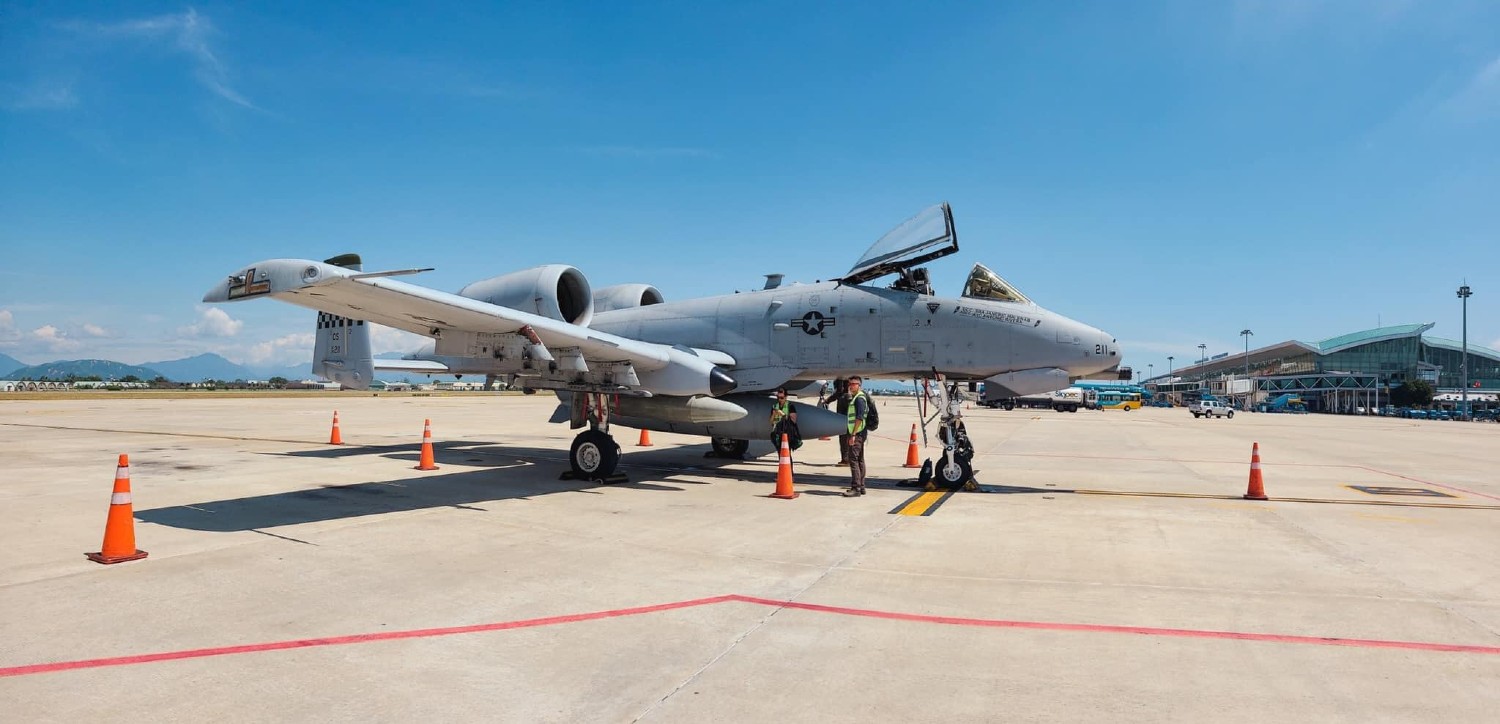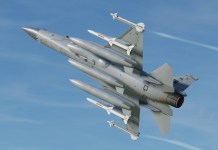In an unprecedented touchdown, Fairchild Republic A-10 Thunderbolt II’ Warthog’ of the US Air Force landed in Vietnam. This is the first citing of the ‘tank killer’ and a Close Air Support (CAS) aircraft in Vietnam since the normalization of its ties with the US.
The ‘Warthog’ has been in the news as the US Congress has been recommending to phase out the aircraft serving in the USAF for 51 years.
The most notable feature of A-10s is General Electric’s GAU-8 30mm rotary cannon. Mounted on its nose, the Gatling gun is one of its kind fitted on an aircraft to date.
Its rapid bursts, seven barrels firing 65 rounds per second, have turned “an enemy soldier’s bowels to water.” The aircraft was conceived after the debacle of the US aircraft in providing close air support to its ground troops.
The A-10 flew for the first time on May 10, 1972, as the Vietnam War was winding down.
“Fairchild Republic A-10 Thunderbolt II attackers of the United States Air Force chilling in Da Nang International Airport (Da Nang, Vietnam) – Saigon Ground Services. Their tail insignia suggests that these hogs belong to 51st Fighter Wing based in Osan Air Base, South Korea,” Lee Ann Quann, a military enthusiast, said on Twitter while sharing the photographs of the Warthog on the tarmac.
Vietnam is the refueling halt for aircraft before or after crossing the ocean. But the real news is the bonhomie that the US and Vietnam have achieved by putting the bloody business of 1971 behind them.
"Hogs"
Fairchild Republic A-10 Thunderbolt II attackers of United States Air Force chilling in Da Nang International Airport (Da Nang, Vietnam) – Saigon Ground Services. Their tail insignia suggests that these Hogs belong to 51st Fighter Wing based in Osan Air Base, South Korea. pic.twitter.com/Ygf08hLP3j
— Lee Ann Quann (@AnnQuann) June 18, 2023
Former US Air Attache to Vietnam Raymond Powell also lauded this development. “Can anyone recall when US combat (A-10 or F-anything) aircraft were allowed to stop in Vietnam? It didn’t happen when I was air attache (2013-16),” Powell said on Twitter.
Powell has retired from the USAF and is leading Project Myoushu in Gordion Knot Center for National Security Innovation at Stanford University. Project Myoushu seeks to develop more effective tools to shine a light into the gray zone of China’s maritime coercion strategy in the South China Sea.
Powell is right; it was in March 2022 that a couple of Boeing CV-22 Osprey landed in Vietnam. The landing of A-10 Thunderbolt II comes as China Coast Guard ship 5901, the world’s largest coast guard ship, entered Vietnam’s Exclusive Economic Zone (EEZ) and coincided with US Secretary of State Antony Blinken’s China visit.
No Warthog To The Boneyard
The USAF has been waging a long war to send the 1970s-era planes to the boneyard, saying it will save roughly US$4 billion in operating costs.
They contend that A-10 missions can be done by other aircraft, including the F-35. But the US Congress has vetoed it repeatedly, primarily because of technical delays and cost overruns in the F-35 development program.
Those favoring mothballing the A-10s contend that the airplane is great in an uncontested environment. And they remain ambivalent about how it will perform in more contested environments in the future.
After decades of wrangling, the US Congress has approved the retirement of 21 A-10s in the 2023 fiscal year. The fiscal year 2023 National Defense Authorization Act would allow the Air Force to mothball 21 of its fleet of 281 venerable A-10 ‘Warthog’ aircraft, marking the first time in roughly a decade that lawmakers have not intervened to prevent the Air Force from retiring any A-10s.
US Senator Marco Rubio said it was a “right call” to retire A-10 as they are no longer suited to the US geostrategic needs. However, he said, the USAF “should not simply dispose of its venerable plane.” “In the hands of our international partners, it can continue advancing the national interest.”
He says that the aircraft can bolster Ukraine’s defenses against Soviet-era tanks. For one, Ukraine’s defense intelligence chief believes Ukraine would fare better with A-10s. Moreover, F-16s require 6,000 feet of tarmac — increasingly rare in bombed-out Ukraine — to take off and land, while A-10s only require 4,000 feet of dirt runway.
“Beyond Ukraine, potential beneficiaries of an A-10 transfer program include African countries in the Sahel fighting ISIS and Boko Haram or Latin American combating paramilitary rebels and drug cartels in the jungle,” the senator added.
A-10 – From ‘A Leprous Project Led By A Pariah’ To Becoming The Military’s Favorite Plane
The USAF had deployed F-5 Phantoms and F-111s in Vietnam, but both failed to perform at low speeds. Then, the Fairchild Republic came in with a design for an unusual aircraft that was nearly as long as it was wide.
The fuselage was little more than a massive 30mm rotary cannon with a cockpit stuck on top. It was called “a leprous project led by a pariah” (Robert Coram in the book titled ‘Boyd.’)

The A-10 specifications team interviewed every pilot who flew during the Vietnam War and forward air controller. They all prioritized long loiter time, good range, excellent visibility, low-and-slow maneuverability, survivability, and lethal weapons. Thus came the A-10 Thunderbolt II, which valued “resiliency” and “function” over all else.
For years it was ignored as a stepchild of its F-plane playmates. A-10 was a shotgun marriage of World War II technology, turbofan engines, and massive artillery. The pilots had expected a smaller, lighter, more maneuverable airplane than what the Warthog turned out to be. The single-seater aircraft was a simple airplane, and until post-production upgrades happened in 1989, it lacked an autopilot. It did not even have a radar.
Another thing that the pilots did not favor was that it was painfully slow. It can do just over 365 knots but usually flies strikes at 300 knots or less. The jokes are that A-10s don’t have instrument panel clocks; they have calendars, and bird strikes from behind are a significant risk.
In the 1980s, when A-10 was deployed in West Germany at the peak of the Cold War, the flying branch predicted that if the A-10s went into action, seven percent of the jets would be lost per 100 sorties, translating to at least 10 A-10s being shot down every 24 hours. Contrary to the prediction, only seven Warthogs have been shot down or crashed due to combat.
It was all set to retire when it got its chance to fight against T-55, T-62, and T-72 – a fight it was designed for. The first Gulf War gave A-10s a second lease of life as they busted through tanks belonging to Saddam Hussain.
It turned out to be the most potent armor-killer ever to fly. The A-10 was also designed around a specific weapon—the General Electric GAU-8/A seven-barrel Gatling cannon, which, with its vast 1,174-round ammunition drum (mounted behind the pilot), is as big as a car. It fires 30mm cartridges nearly a foot long.
After its success in Operation Desert Storm, the aircraft earned many monikers like ‘Warthog,’ ‘Flying Gun,’ and the ‘Tankbuster.’ It was later deployed in support of NATO operations in Kosovo, as well as in Operation Enduring Freedom in Afghanistan and Operation Iraqi Freedom. Its high survivability made it highly popular with pilots. It is effective as it can loiter near battle areas for extended periods and operate in low ceiling and visibility conditions.
A-10s are all set to be replaced by Lockheed Martin’s multi-role fighter F-35 Lightening II. But every pilot who has flown the A-10 makes a strong case for the A-10’s prowess. They say Warthog is cheap to fly, is already in operation, and has a greater loitering capability that the F-35 will always lack.
- Ritu Sharma has written on defense and foreign affairs for over a decade. She holds a Master’s Degree in Conflict Studies and Management of Peace from the University of Erfurt, Germany. Her areas of interest include Asia-Pacific, the South China Sea, and Aviation history.
- She can be reached at ritu.sharma (at) mail.com




